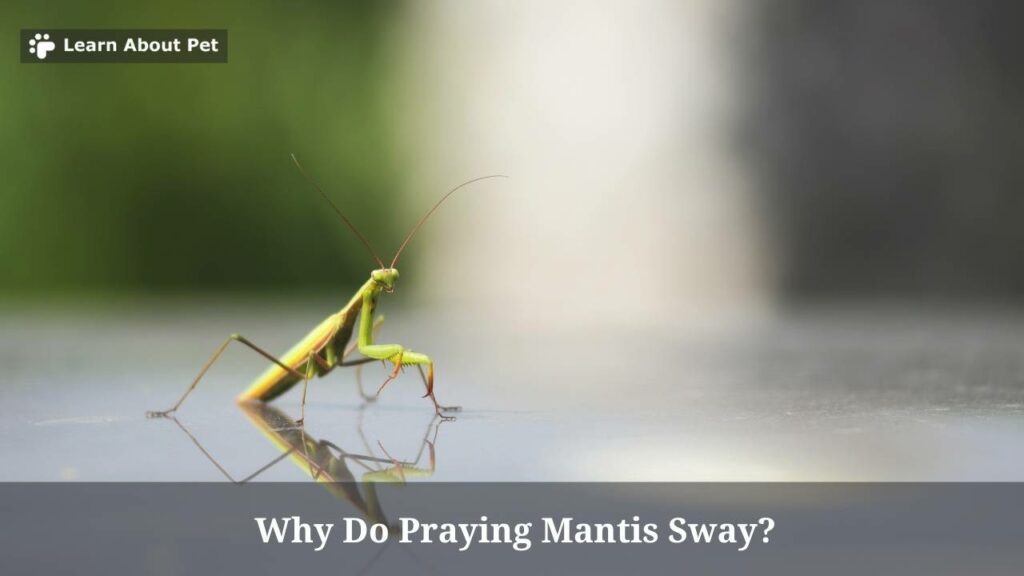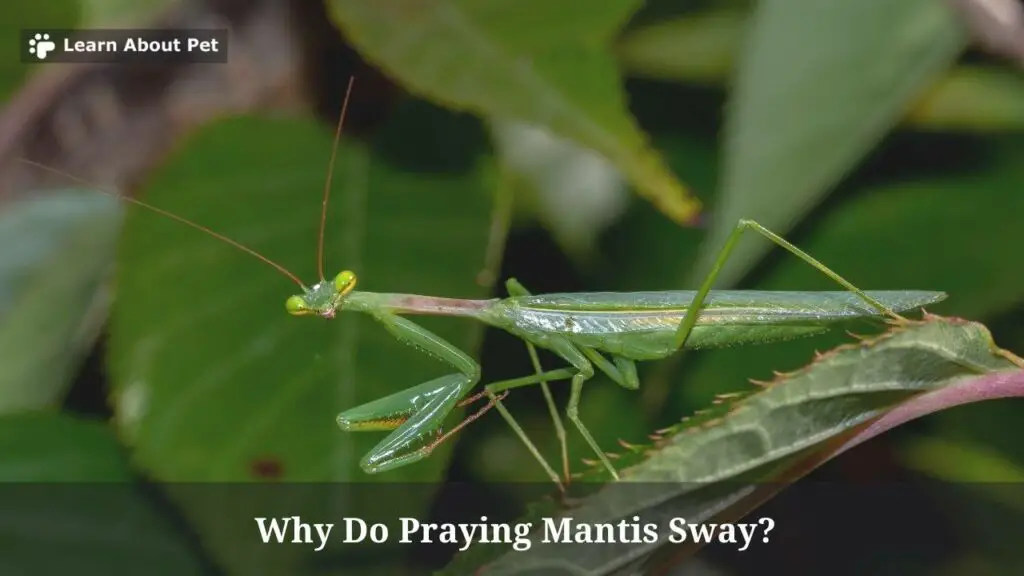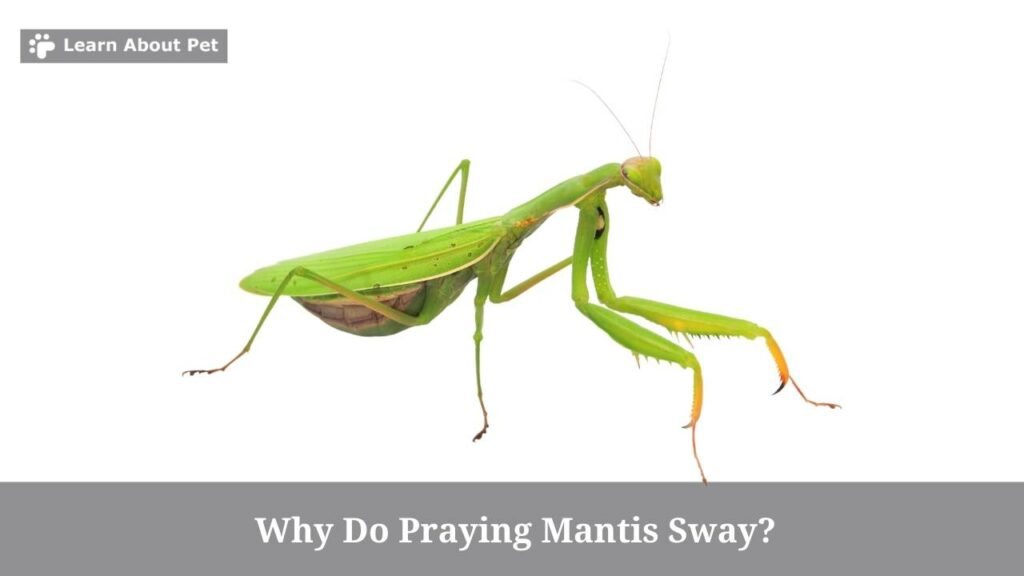Praying mantis are predatory animals that attract crowds with their weird moves. You’ll notice dancing or swaying mantis motions if you see a praying mantis in the wild. The movement looks intimidating, and we don’t see other insects doing the same thing. What made praying mantis do that?
Why do praying mantis sway? There are several reasons why praying mantis sway, such as mating, mimicking how nature moves, orienting in space, preparing to jump, or seeing objects far from them. Swaying is an action to benefit the praying mantis to hide from predators or to carry out its activities.
Knowing in more detail how to pray mantis sway is interesting. Let’s read this article to the end.

Why Do Mantis Sway?
Mantis can measure up to two inches long. With that size, they have many natural predators, such as snakes, birds, and spiders. Their long slim bodies require protection or hiding from predators.
One of the praying mantis strategies to hide from predators is swaying to trick any predators that are hunting them.
Why Do Praying Mantis Sway?
The first possibility of praying mantis swaying is camouflage. Mantis will perform repetitive movements, rocking side-to-side to make them move like a leaf blowing in the wind.
Predators watching from afar will mistake the praying mantis for leaves.
Mantis has this technique to protect them from larger predators, with their body color adapting to their environment. The vegetation moving method is a surefire step for sweets to survive in the wild.
Why Does A Praying Mantis Sway Side To Side?
Praying mantis will sway to explain their long-distance view because they don’t have a complex system of sight. Praying mantis cannot see far.
Mantis can only see far away through sway or repetitive movements side-to-side to distinguish objects in the foreground and background.
Although praying mantis has three-dimensional vision, it causes poor image resolution or not being able to see objects from afar and seems blurry.
Praying mantis will sway if they locate potential prey or moving creatures from afar.
Why Is The Praying Mantis Dancing?
Praying mantis dancing is one of the seduction techniques when looking for partners. Male praying mantises dance seductively to attract a mate.
To get the partner that the mantis wants, the mantis will show the best dance moves. The females will accept their invitation to mate if the females are interested in the male moves.
Not all mating encounters go smoothly. A quarter of mating encounters end with female mantis kill and eating their partner, after or during intercourse.
The female mantis step starts with biting the male’s heads off for a nutrient boost when laying their eggs. There is a theory from scientists who state that male praying mantis can help women produce more eggs.
Is It OK To Hold A Praying Mantis?
Many people are curious about praying mantis and want to hold them straight. You can hold the praying mantis with your bare hands, but there’s a chance they will hurt you.
Praying mantis has sharp spines and barbed teeth that can make cuts to your skin.
The praying mantis body is long and fragile because it does not have much flesh. If you immediately reach out to pick the mantis up, the praying mantis feels under attack and will harm you.
Just place a praying mantis in your hand and let them move around your palm. Don’t hold the mantis too tight.

Are You Not Supposed To Touch Praying Mantis?
Praying mantis will not hurt humans. They cannot sting or have no venom. No possibility praying mantis will carry an infectious disease. You are allowed to handle mantis, but be careful with their sharp spines or teeth.
If you can safely pick up the praying mantis in your hand, let them walk to your palm. Praying mantis can be docile to owners. You don’t need to grip their bodies hard because praying mantis have fragile bodies.
Why Do Praying Mantis Dance?
Praying mantis are predators who will dance as an element of surprise to conceal their prey before ambushing.
Praying mantis ensures the prey has no time to act or escape from them. Some types of praying mantis have colors that almost match their environment.
When praying mantis dance, they will look like plants that are nearby. They are trying to get the attention of butterflies, bees, or beetles.
Once the prey is close enough, the praying mantis will do the perfect ambush. Their spiked legs will kill the prey instantly with feast on heads first.
Why Do Praying Mantis Sway Side To Side?
Praying mantis will sway when they bounce around in bushes. Before they reach adulthood, the praying mantis will perform acrobatic leaps.
Before praying mantis jumps from one leaf to another, they need dancing motions or sway while calculating the leap distance.
After the praying mantis is ready, it will be calculated to pirouette in the middle of the air. Praying mantis can gain momentum and land at the designated spot.
The dance or sway is not too long, and to humans, it will look like a blink of an eye.
What Does It Mean When A Praying Mantis Sways?
The praying mantis performs repetitive moves side-to-side to perform several possible activities. This rhythmic motion is a spectacular sight even though it looks weird to us.
The table below is some of the potential reasons why praying mantis sways.
| Praying mantis sway possibility | Explanation |
| Camouflage | Avoids predators by moving its body to make it look like a leaf blowing in the wind. |
| Seeing objects in the distance | Praying mantis do not have complex eyesight and need to move their bodies to distinguish objects in the back and foreground. |
| Ambush attack | Praying mantis will attract prey before making a surprise attack. |
| Jumping | Praying mantis requires momentum to jump from one branch to another. |
| Mating process | Male praying mantis show their best dance moves to attract female interest before the mating process. |
Why Do Praying Mantis Wobble?
It depends on what the praying mantis is doing. If you see praying mantis facing each other and one of them swaying, the praying mantis dancing is a step to attract the interest of the other mantis.
Or when you see praying mantis on the edge of the branch or leaves, they will jump and create momentum before leaps.
What Attracts Praying Mantis?
Praying mantis can be good pests or good predators to keep your garden. To attract praying mantis in the wild, you’ll need to grow mantis-attracting plants. Raspberry canes, marigolds, fennel, dill, and angelica are herbs or plants that can attract praying mantises.
Place the plant on the low ground with a shady place to pray the mantis has places to hide from predators.
Why Do Praying Mantis Stare At You?
It depends on how far away you are from the praying mantis. If you’re far enough from them, the praying mantis won’t see you. They cannot see far. If you are close to them, pray mantis is aware of what you will do to them.
Why do praying mantis sway? The praying mantis will move left and right repeatedly to distinguish the objects so that they can see far away. The praying mantis wanted to know if there was any threat or prey they could see.
Final Verdict – Why Do Praying Mantis Sway
Praying mantis perform their unique dancing moves to perform several activities such as jumping, mating, camouflage, defense system, and seeing objects from afar. They will sway to the right and the left while doing the activity they are going to do.

Look at the state of the praying mantis when they sway. Are there other mantis and mantis seducing a potential mate, do mantis want to jump on branches, are any predators targeting them, or do they have prey near their area? That’s the possibility of why praying mantis sway.
As a pet lover, make sure to learn about pet more and give your pet mantis a good and comfortable life!

Welcome to Learn About Pet. My name is Rajkumar Ravichandran and I love all pets, travel, and amazing food. I write about my passion and personal experience caring for multiple pets in this blog! ❤️
Post Disclaimer
DISCLAIMER: THIS BLOG OR WEBSITE, "Learn About Pet", DOES NOT PROVIDE YOU WITH MEDICAL ADVICE AND IS NOT A SUBSTITUTE FOR MEDICAL ADVICE. ALWAYS GET IN TOUCH WITH YOUR PERSONAL VETERINARIAN AND USE INFORMATION HERE AS GENERAL ADVICE.
The information, including but not limited to, text, graphics, images and other material contained on this website are for informational purposes only. No material on this site is intended to be a substitute for professional veterinary advice, food recommendation, diagnosis, or treatment. Always seek the advice of your veterinarian or other qualified health care provider with any questions you may have regarding a medical condition or for pet food related questions.







